Dergraduate laboratory courses. We present the theory, psychometric properties, and initial
Dergraduate laboratory courses. We present the theory, psychometric properties, and initial predictive abilities from the student Persistence in the Sciences (PITS) survey. The get Protirelin (Acetate) survey was constructed from a series of current instruments which have looked at distinct psychological components relevant to science education and was then validated for its capacity to address persistence. The PITS survey is created for use in conjunction with the improvement of CREs. It presents a way of assessing the consequences of these courses in terms of student outcomes and retention potential. The analysis we present can be a validation study of the PITS survey. The aim is to make the PITS instrument accessible for those science educators and researchers who are at the moment developing new revolutionary courses aimed to boost STEM retention rates. We provide proof not merely that the instrument supplies a way of measuring relevant variables that underpin student persistence choices but in addition proof around the techniques in which these measures could possibly be linked to persistence. The paper as a whole also provides an method for the improvement and validation of additional sophisticated assessment tools that recognize the specificities on the type of educational opportunities embedded in a CRE. A Psychological Measurement Model of Persistence The model we propose and evaluate right here resulted from 3 developments relating for the aim of enhancing retention in undergraduate science majors: the pedagogical development of course-based analysis experiences (CREs; Hanauer et al; Auchincloss et al; Corwin et al); the improvement of a series of assessment tools focusing on undergraduate investigation experiences and retention (Chemers et al; Estrada et al; Hanauer and Dolan, ; Hanauer and Hatfull,); and the improvement of a theoretical orientation that integrated scholarship relating to persistence (Graham et al). At its most standard level, the model suggests that retention PubMed ID:http://www.ncbi.nlm.nih.gov/pubmed/25730865?dopt=Abstract might be improved by way of the usage of CREs; that these educational experiences result in a series of measurable psychological states; and that, if desirable levels of these states exist, then the likelihood that these students will keep within the sciences will enhance.:ar,Prior analysis has proposed a series of potential psychological outcomes of analysis experiences which might be worth taking into consideration within a broader model of persistence inside the sciences. Very first, and most straight related to current  developments in the pedagogy of CREs, will be the variable of project ownership. The idea of project ownership emerged straight from the educational work conducted in relation for the improvement of a large and well-established CRE (Hatfull,) and was validated as a measurement variable in relation to a series of other research experiences and CREs (Hanauer et al; Hanauer and Dolan,). Determined by analyses of dimensionality, project ownership was found to differentiate into two aspects: the content material scales and emotional scales of project ownership (Hanauer and Dolan,). The importance of project ownership as a variable is the fact that it is an interactional variable that reflects the student’s self-positioning in relation to the experience of the undergraduate analysis laboratory course. The construct of project ownership involves elements of engagement, agency, individual connection, the recognition of neighborhood and disciplinary worth, and positive emotive responses. Validation studies of project ownership have shown it to be specifically sensitive towards the unique.
developments in the pedagogy of CREs, will be the variable of project ownership. The idea of project ownership emerged straight from the educational work conducted in relation for the improvement of a large and well-established CRE (Hatfull,) and was validated as a measurement variable in relation to a series of other research experiences and CREs (Hanauer et al; Hanauer and Dolan,). Determined by analyses of dimensionality, project ownership was found to differentiate into two aspects: the content material scales and emotional scales of project ownership (Hanauer and Dolan,). The importance of project ownership as a variable is the fact that it is an interactional variable that reflects the student’s self-positioning in relation to the experience of the undergraduate analysis laboratory course. The construct of project ownership involves elements of engagement, agency, individual connection, the recognition of neighborhood and disciplinary worth, and positive emotive responses. Validation studies of project ownership have shown it to be specifically sensitive towards the unique.